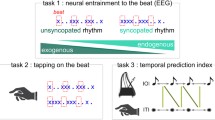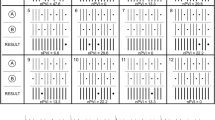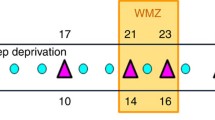Abstract
Recent neurophysiological findings in relation to thalamocortical mechanisms for sensory processing, together with established anatomical and expanding functional evidence, have provided a rational theoretical framework for the interpretation of normal and abnormal EEG rhythmic activities. This perspective is integrated here with earlier animal studies which were the foundation for many current applications of EEG self-regulation as a clinical tool. Basic evidence concerning the origins, frequency modulation, and functional significance of normal EEG rhythmic activities is reviewed here in an effort to provide guiding principles for the interpretation of clinical abnormalities and their remediation with EEG feedback training.
Similar content being viewed by others
References
Andersen, P., & Andersson, S. A. (1968).Physiological basis of the alpha rhythm. New York: Appleton-Century-Crofts.
Babb, M. I., & Chase, M. H. (1974). Masseteric and digastric reflex activity during conditioned sensorimotor rhythm.Electroencephalography and Clinical Neurophysiology, 36, 357–365.
Baldy-Moulinier, M. (1982). Temporal lobe epilepsy and sleep organization. In M. B. Sterman, M. N. Shouse, & P. Passouant (Eds.),Sleep and epilepsy (pp. 347–359). New York: Academic.
Berger, H. (1930). On the electroencephalogram of man, II.Journal for Psychology and Neurology, 40, 160–179.
Berlyne, D. E. (1971).Aesthetics and psychobiology. New York: Appleton-Century-Crofts.
Boff, K. R., Kaufman, L., & Thomas, J. P. (1986).Handbook of perception and human performance: Vol. II,Cognitive processes and performance. New York: Wiley-Interscience.
Bouyer, J. J., Dedet, L., Debray, O., & Rougeul, A. (1978). Restraint in primate chair may cause unusual behavior in baboons; Electrocorticographic correlates and corrective effects of diazepam.Electroencephalography and Clinical Neurophysiology, 44, 562–567.
Bouyer, J. J., Dedet, L., Konya, A., & Rougeul, A. (1974). Convergence de trois systemes rhythmiques thalamocorticaux sur l'aire somesthesque du chat et du babouin normaux.Review EEG Neurophysiologie, 4, 397–406.
Bowersox, S. S., Siegel, J. M., & Sterman, M. B. (1978). Effects of restraint on EEG variables and monomethylhydrazine seizures in the cat.Experimental Neurology, 61, 154–164.
Bowersox, S. S., & Sterman, M. B. (1981). Changes in sensorimotor sleep spindle activity and seizure susceptibility following somatosensory deafferentation.Experimental Neurology, 74, 814–828.
Bowersox, S. S., & Sterman, M. B. (1982). Effects of somatosensory deafferentation on spectral characteristics of the sensorimotor EEG in the adult cat.Experimental Neurology, 77, 403–418.
Carpenter, M. B. (1991).Core text of neuroanatomy (4th ed., Chap. 5). Baltimore: Williams & Wilkins.
Chase, M. H., & Harper, R. M. (1971). Somatomotor and visceromotor correlates of operantly conditioned 12–14 c/s sensorimotor cortical activity.Electroencephalography and Clinical Neurophysiology, 31, 85–92.
Cowan, J. D. (1993). Alpha-theta brainwave biofeedback: The many possible theoretical reasons for its success.Biofeedback, 21, 11–16.
Galletti, C., Battaglini, P. P., & Fattori, P. (1993). Parietal neurons encoding spatial locations in craniotopic coordinates.Experimental Brain Research, 96, 221–229.
Gloor, P., Pellegrini, A., & Kostopoulos, G. K. (1979). Effects of changes in cortical excitability upon the epileptic bursts in generalized penicillin epilepsy of the cat.Electroencephalography and Clinical Neurophysiology, 46, 274–289.
Hamel, A. R., & Sterman, M. B. (1982). Sleep and epileptic abnormalities during sleep. In M. B. Sterman, M. N. Shouse, & P. Passouant (Eds.),Sleep and epilepsy (pp. 361–377). New York: Academic.
Harper, R. M., & Sterman, M. B. (1972). Subcortical unit activity during a conditioned 12–14 Hz sensorimotor EEG rhythm in the cat.Federation Proceedings, 31, 404.
Holcomb, V., Sterman, M. B., Goodman, S. J., & Fairchild, M. D. (1979). The immobilization response in rhesus monkeys: a behavioral and electroencephalographic study.Experimental Neurology, 63, 420–435.
Howe, R. C., & Sterman, M. B. (1972). Cortical-subcortical EEG correlates of suppressed motor behavior during sleep and waking in the cat.Electroencephalography and Clinical Neurophysiology, 32, 681–695.
Howe, R. C., & Sterman, M. B. (1973). Somatosensory system evoked potentials during waking behavior and sleep in the cat.Electroencephalography and Clinical Neurophysiology, 34, 605–618.
Jasper, H. H., & Penfield, W. (1949). Electrocorticograms in man: Effect of the voluntary movement upon the electrical activity of the precentral gyrus.Archives of Psychiatry and Neurology, 183, 163–174.
Jones, E. G. (1985).The thalamus, New York: Plenum.
Krosigk, M. von, Bal, T., & McCormick, D. A. (1993). Cellular mechanisms of a synchronized oscillation in the thalamus.Science, 261, 361–364.
Kuhlman, W. N., & Kaplan, B. J. (1979). Clinical applications of EEG feedback training. In R. J. Gatchel & K. P. Price (Eds.),Clinical applications of biofeedback: Appraisal and status. New York: Pergamon.
Lantz, D., & Sterman, M. B. (1988). Neuropsychological assessment of subjects with uncontrolled epilepsy: Effects of EEG feedback training.Epilepsia, 29, 163–171.
Llinas, R., & Jahnsen, H. (1982). Electrophysiology of mammalian thalamic neurons.Nature, 297, 406–408.
Lopes da Silva, F. H., Van Leirop, T. H. M. T., Schrijer, C. F. M., & Storm van Leeuwen, W. (1973). Organization of thalamic and cortical alpha rhythm: Spectra and coherences.Electroencephalography and Clinical Neurophysiology, 35, 627–639.
Lopes da Silva, F. H., Vos, J. E., Mooibroek, J., & Van Rotterdam, A. (1980). Relative contributions of intracortical and thalamocortical processes in the generation of alpha rhythms, revealed by partial coherence analyses.Electroencephalography and Clinical Neurophysiology, 50, 449–456.
Lubar, J. F., & Bahler, W. W. (1976). Behavioral management of epileptic seizures following biofeedback training of the sensorimotor rhythm.Biofeedback and Self-Regulation, 1, 77–104.
Lubar, J. O., & Lubar, J. F. (1984). Electroencephalographic biofeedback of SMR and beta for treatment of attention deficit disorders in a clinical setting.Biofeedback and Self-Regulation, 9, 1–23.
Lubar, J. F., & Shouse, M. N. (1976). EEG and behavioral changes in a hyperkinetic child concurrent with training of the sensorimotor rhythm (SMR): A preliminary report.Biofeedback and Self-Regulation, 3, 293–306.
Mann, C. A., Lubar, J. F., Zimmerman, A. W., Miller, C. A., & Muenchen, R. A. (1992). Quantitative analysis of EEG in boys with attention-deficit-hyperactivity disorder: Controlled study with clinical implications.Pediatric Neurology, 8, 30–36.26.
Mann, C. A., Sterman, M. B., Suyenobu, B. Y., & Kaiser, D. A. (1995). Suppression of EEG rhythmic frequencies during somato-motor and visuo-motor behavior.International Journal of Psychophysiology, in press.
McCormick, D. A. (1992). Neurotransmitter actions in the thalamus and cerebral cortex and their role in neuromodulation of thalamocortical activity.Progress in Neurobiology, 39, 337–388.
McCormick, D. A., & Huguenard, J. R. (1992). A model of the electrophysiological properties of thalamocortical relay neurons.Journal of Neurophysiology, 68, 1384–1400.
Pavlov, I. P. (1927).Conditioned reflexes. Oxford: Oxford U.P.
Peniston, E. G., & Kulkosky, P. J. (1989). Alpha-theta brainwave training and b-endorphin levels in alcoholics.Alcoholism: Clinical and Experimental Research, 13, 271–279.
Peniston, E. G., & Kulkosky, P. J. (1990). Alcoholic personality and alpha-theta brainwave training.Medical Psychotherapy, 3, 37–55.
Pfurtscheller, G. (1981). Central beta rhythm during sensory motor activities in man.Electroencephalography and Clinical Neurophysiology, 51, 253–264.
Pfurtscheller, G. (1992). Event-related synchronization (ERS): An electrophysiological correlate of cortical areas at rest.Electroencephalography and Clinical Neurophysiology, 83, 62–69.
Pfurtscheller, G., & Aranibar, A. (1977). Event-related cortical desynchronization detected by power measurements of scale EEG.Electroencephalography and Clinical Neurophysiology, 42 817–826.
Pfurtscheller, G., & Klimesch, W. (1991). Event-related desynchronization during motor behavior and visual information processing. In C. H. M. Brunia, G. Mulder, & M. N. Verbaten (Eds.),Event-related brain research (pp. 58–65). (EEG Suppl. 42).
Pinault, D., & Deschenes, M. (1992). Voltage-dependent 40-Hz oscillations in rat reticular thalamic neurons in vivo.Neuroscience, 51, 245–258.
Ray, W., & Cole, H. (1985). EEG alpha activity reflects attentional demands, and beta activity reflects emotional and cognitive processes.Science, 228, 750–752.
Rosen, I., Blennow, G., Risberg, A. M., & Ingvar, D. H. (1982). Quantitative evaluation of nocturnal sleep in epileptic children. In M. B. Sterman, M. N. Shouse, & P. Passouant (Eds.),Sleep and epilepsy, (pp. 397–409). New York: Academic.
Roth, S. R., Sterman, M. B., & Clemente, C. C. (1967). Comparison of EEG correlates of reinforcement, internal inhibition, and sleep.Electroencephalography and Clinical Neurophysiology, 23, 509–520.
Rougeul, A., Bouyer, J. J., Dedet, L., & Debray, O. (1979). Fast somatoparietal rhythms during combined focalized attention and immobility in baboon and squirrel monkey.Electroencephalography and Clinical Neurophysiology, 46, 310–319.
Shouse, M. N., & Lubar, J. F. (1979). Operant conditioning of EEG rhythms and ritalin in the treatment of hyperkinesis.Biofeedback and Self-Regulation, 4, 299–312.
Shouse, M. N., Siegel, J. M., Wu, M. F., Szymusiak, R., & Morrisson, A. R. (1989). Mechanisms of seizure suppression during rapid eye movement (REM) sleep in cats.Brain Research, 505, 271–282.
Shouse, M. N., & Sterman, M. B. (1979). Changes in seizure susceptibility, sleep time and sleep spindles following thalamic and cerebellar lesions.Electroencephalography and Clinical Neurophysiology, 46, 1–12.
Sprague, J. M. (1966). Visual, acoustic and somesthetic deficits in the cat after cortical and midbrain lesions. In D. Purpura & M. Yahr (Eds.).The thalamus (pp. 391–414). New York: Columbia U.P.
Steriade, M., Curro Dossi, R., & Nunez, A. (1991). Network modulation of a slow intrinsic oscillation of cat thalamocortical neurons implicated in sleep delta waves: cortically induced synchronization and brainstem cholinergic suppression.The Journal of Neuroscience, 11, 3200–3217.
Steriade, M., & Deschenes, M. (1988). Intrathalamic and brainstem-thalamic networks involved in resting and alert states. In M. Bentivoglio & R. Spreafico (Eds.).Cellular thalamic mechanisms (pp. 37–62). Amsterdam: Elsevier.
Steriade, M., & Llinas, R. R. (1988). The functional states of the thalamus and the associated neuronal interplay.Physiological Reviews, 68, 649–742.
Steriade, M., Gloor, P., Llinas, R. R., Lopes da Silva, F. H., & Mesulam, M. M. (1990). Basic mechanisms of cerebral rhythmic activities.Electroencephalography and Clinical Neurophysiology, 76, 481–508.
Sterman, M. B. (1977). Effects of sensorimotor EEG feedback training on sleep and clinical manifestations of epilepsy. In J. Beatty and H. Legewie (Eds.),Biofeedback and behavior (pp. 167–200). New York: Plenum.
Sterman, M. B. (1981). Power spectral analysis of EEG characteristics during sleep in epileptics.Epilepsia, 22, 95–106.
Sterman, M. B. (1982). EEG biofeedback in the treatment of epilepsy: An overview circa 1980. In L. White & B. Tursky (Eds.),Clinical biofeedback: Efficacy and mechanisms (pp. 311–330). New York: Guilford.
Sterman, M. B. (1986). Epilepsy and its treatment with EEG feedback therapy.Annals of Behavioral Medicine, 8, 21–25.
Sterman, M. B. (1993). Sensorimotor EEG feedback training in the study and treatment of epilepsy. In D. I. Mostofsky & Y. Loyning (Eds.).Neurobehavioral treatment of epilepsy (pp. 1–17). New Jersey: Erlbaum.
Sterman, M. B., & Bowersox, S. S. (1981). Sensorimotor electroencephalograph rhythmic activity: A functional gate mechanism.Sleep, 4, 408–422.
Sterman, M. B., & Friar, L. (1972). Suppression of seizures in an epileptic following sensorimotor EEG feedback training.Electroencephalography and Clinical Neurophysiology, 33, 89–95.
Sterman, M. B., Goodman, S. J., & Kovalesky, R. A. (1978). Effects of sensorimotor EEG feedback training on seizure susceptibility in the rhesus monkey.Experimental Neurology, 62, 735–747.
Sterman, M. B., Howe, R. D., & MacDonald, L. R. (1970). Facilitation of spindle-burst sleep by conditioning of electroencephalographic activity while awake.Science, 167, 1146–1148.
Sterman, M. B., Kaiser, D. A., & Veigel, B. (1995). Event-related EEG spectra responses during the Continuous Performance Test.Electroencephalography and Clinical Neurophysiology, submitted.
Sterman, M. B., LoPresti, R. W., & Fairchild, M. D. (1969). Electroencephalographic and behavioral studies of monomethylhydrazine toxicity in the cat. Technical Report AMRL-TR-69-3, Wright-Patterson Air Force Base, Ohio, Air Systems Command.
Sterman, M. B., & Macdonald, L. R. (1978). Effects of central cortical EEG feedback training on incidence of poorly controlled seizures.Epilepsia, 19, 207–222.
Sterman, M. B., MacDonald, L. R., & Stone, R. K. (1974). Biofeedback training of the sensorimotor EEG rhythm in man: Effects on epilepsy.Epilepsia, 15, 395–417.
Sterman, M. B., & Mann, C. A. (1995). Concepts and applications of EEG analysis in aviation performance evaluation.Biological Psychology, 40, 115–130.
Sterman, M. B., Mann, C. A., Kaiser, D. A., & Suyenobu, B. Y. (1994). Multiband topographic EEG analysis of a simulated visuomotor aviation task.International Journal of Psychophysiology, 16, 49–56.
Sterman, M. B., & Shouse, M. N. (1980). Quantitative analysis of training, sleep EEG, and clinical response to EEG operant conditioning in epileptics.Electroencephalography and Clinical Neurophysiology, 49, 558–576.
Sterman, M. B., & Wyrwicka, W. (1967). EEG correlates of sleep: Evidence for separate forebrain substrates.Brain Research, 6, 143–163.
Sterman, M. B., Wyrwicka, W., & Roth, S. R. (1969). Electrophysiological correlates and neural substrates of alimentary behavior in the cat.Annals of the New York Academy of Science, 157, 723–739.
Stone, L. S., & Lisberger, S. G. (1990). Visual responses of purkinje cells in the cerebellar flocculus during smooth-pursuit eye movements in monkeys: II. Complex Spikes.Journal of Neurophysiology, 63, 1262–1275.
Tansey, M. A. (1985). Brainwave Signatures. An index reflective of the brain's functional neuroanatomy: Further findings on the effect of EEG sensorimotor rhythm feedback training on the neurologic precursors of learning disabilities.International Journal of Psychophysiology, 4, 91–97.
Veigel, B., & Sterman, M. B. (1993). Topographic EEG correlates of good and poor performance in a signal recognition task.Proceedings of the Human Factors Society 37th Annual Meeting, 1, 147–151.
Wickramasekera, I. (1993). Observations, speculations and an experimentally testable hypothesis on the mechanism of the presumed efficacy of the Peniston and Kulkosky procedure.Biofeedback, 21, 17–20.
Warren, R. A., & Jones, E. G. (1994). Glutamate activation of cat thalamic reticular nucleus: Effects on response properties of ventroposterior neurons.Experimental Brain Research, 100, 215–226.
Wood, J. D., & Peesker, S. J. (1974). Development of an expression which relates the excitable state of the brain to the level of GAD activity and GABA content, with particular reference to the action of hydrazine and its derivatives.Journal of Neurochemistry, 23, 703–712.
Wyler, A. R. (1984). Operant conditioning of single neurons in monkeys and its theoretical application to EEG operant conditioning in human epilepsy. In Th. Elbert, B. Rockstroh, W. Lutzenberger, & N. Birbaumer (Eds.).Self-regulation of the brain and behavior (pp. 85–94). New York: Springer-Verlag.
Wyrwicka, W., & Sterman, M. B. (1968). Instrumental conditioning of sensorimotor cortex EEG spindles in the waking cat.Physiology and Behavior, 3, 703–707.
Author information
Authors and Affiliations
Additional information
The author wishes to thank the many colleagues whose work and collaboration have contributed to the concepts discussed in this review. In particular, I would like to express my sincere appreciation to Drs. Wanda Wyrwicka, Scott Bowersox, Margaret Shouse, William Kuhlman, Allen Wyler, Ronald Szymusiak, and David Kaiser. I would also like to thank Mrs. Jerri Kaiser for her assistance in the preparation of this manuscript. The work presented here from my laboratory has been supported by the Veterans Administration, the National Institutes of Health, the U.S. Air Force, and the Northrop-Grumman Corporation.
Rights and permissions
About this article
Cite this article
Sterman, M.B. Physiological origins and functional correlates of EEG rhythmic activities: Implications for self-regulation. Biofeedback and Self-Regulation 21, 3–33 (1996). https://doi.org/10.1007/BF02214147
Issue Date:
DOI: https://doi.org/10.1007/BF02214147




